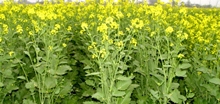GM mustard gets regulatory approval, awaits SC nod
12 May 2017
With the government's Genetic Engineering Appraisal Committee (GEAC), giving its approval for genetically modified (GM) mustard, the condiment is all set for commercial cultivation, but only after the Supreme Court clears an appeal against its introduction.
 A sub-committee of the GEAC has submitted a report on the safety analysis of the new GM mustard, which found the transgenic variety to be on par with its non-GM parents.
A sub-committee of the GEAC has submitted a report on the safety analysis of the new GM mustard, which found the transgenic variety to be on par with its non-GM parents.
An analysis of the key components of GM mustard by the GEAC showed no change in the composition compared to conventional crop varieties of the same species.
"Unlike canola rapeseed mostly grown abroad, Indian mustard seeds have high levels of erucic acid and glucosinolates and are considered less desirable for human consumption, especially in western countries.
''While no significant difference was observed between the GE lines as compared to their non-GE parents for total glucocinates in seeds collected from different centres in the BRL II trials at three locations - Ludhiana PAU), Bhatinda (PAU) and Delhi (IARI), total GSL in hybrid DMH-11 was observed to be intermediate of the two parents - Varuna (high GSL) and EH-2 (low GSL),'' the report pointed out.
There were also no significant difference in the levels of important fatty acids such as Euric acid (22:1), Omega-3 fatty acid (18:2), and Omega-6 fatty acid (18:3) compared to their non-GE parents.
Other parameters like essential B-complex vitamins like Folic acid, Riboflavin, Niacin, Pantothenic acid, Thiamine and Pyridoxine were found to be similar in the seeds as well as in the leaves of the GE parents as compared o their non-GE parents.
Similarly, there were also no significant differences in levels of minerals like calcium, manganese, copper, iron, selenium and zinc in the leaf and seeds of the GE variety compared to their non-GE parents.
The composition analysis also showed that nutritional adequacy of leaves and seeds indicated no evidence of in the nutrient or anti-nutrient qualities with respect to parameters such as fibres, minerals, vitamins, amino acid, fatty acids, and secondary metabolites in leaves and seeds of mustard due to presence of transgenes.
In the light of these, GAEC has concluded that the introduction of barnase, barstar and bargenes into GE mustard does not show any unintended effect on the overall composition of GE plants - either the parentallines or the hybrid DMH - 11.
A final call on the report rests with environment minister Anil Dave. However, whether the crop is commercially released for cultivation or not will depend on the Supreme Court, which is hearing a case seeking a moratorium on the commercial release of the crop.
The apex court has issued a stay on its release and the ministry of environment, forests and climate change will need a sanction from the court before giving its nod.
First developed in the early 2000s, GM mustard was one of the first genetically modified food crops to be considered. However, Bt cotton secured the first approval for commercial release in 2002, and GM mustard now awaits its turn.
GM mustard has been facing criticism from environmentalists, anti-GM activists and the RSS-affiliated Swadeshi Jagran Manch.
The Supreme Court is likely to take up the hearing in July, after court vacations.













.jpg)






.jpg)









